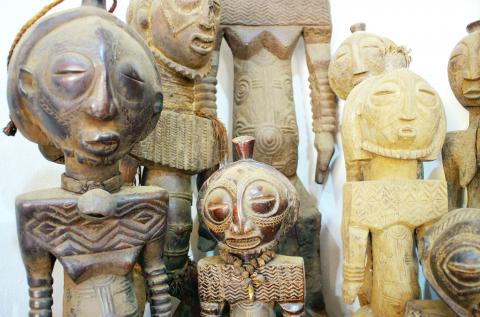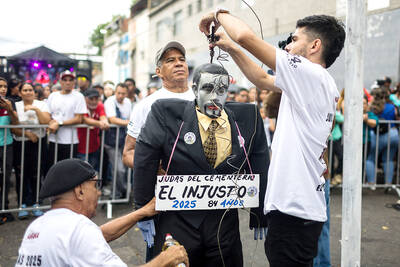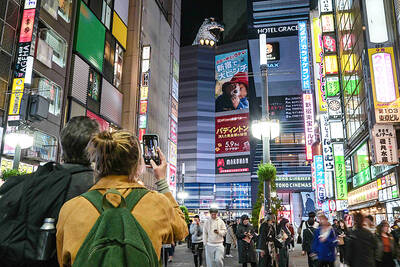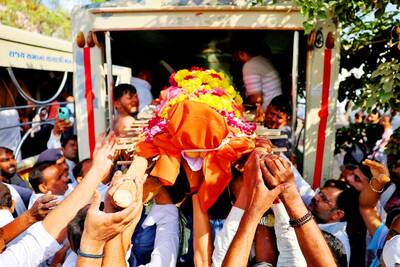Perched on a shelf, the Little Kabila with the mysterious eyes greets visitors to the Kivu Museum, housed in a Catholic mission, but aimed at safeguarding endangered Congolese traditional artifacts that some might consider “satanic.”
The statuette depicting a woman sitting on her heels and holding a jar in her hands used to feature on all Congolese 10-franc notes, but is no longer in circulation.
Former president of the Democratic Republic of the Congo (DR Congo) Laurent-Desire Kabila himself — the father of Congolese President Joseph Kabila — had insisted that she be represented in this way, according to museum guide Barthelemy Kayumba.

Photo: AFP
The museum lies hidden behind the walls of the mission of the Xaverian Fathers, Catholic missionaries of Jesuit influence, in Bukavu, the capital of South Kivu, in eastern DR Congo.
In the Luba language, “kabila means to share or distribute,” Kayumba said.
For the Luba, an ethnic group from the nation’s southeast where the head of state was born, the statuette fulfills “a function of mutual aid and solidarity,” he added.
It also held a symbolic value for Kabila senior, a former rebel chief who in 1997 put an end to Mobutu Sese Seko’s 32-year dictatorship.
“The chief, or the mother, has to take care of the weakest and watch over the youngest,” Kayumba said.
Like many items in the museum, the Little Kabila is a copy. However, the Xaverian Fathers, who first arrived in the nation in 1954, have also amassed authentic pieces, often created for the initiation or nomination ceremony of a mwami (chief), Father Italo said.
Having lived in the DR Congo for nearly 40 years, the Italian priest closely knew Father Andre, the museum’s founder, who is currently undergoing treatment for an undisclosed illness in Europe.
The museum opened its doors to the public in 2013, but the hunt for artifacts began 10 years earlier, at the end of the Second Congo War from 1998 to 2003.
For South Kivu, the end of this African regional war, which took place solely in the DR Congo, did not bring peace.
Like its neighbor Northern Kivu and other parts in the nation’s east, the province remains torn by violence and armed conflicts fueled by Congolese or foreign militias.
The museum has managed all the same to gather an impressive collection of several hundred statuettes, masks and idols thanks to the cooperation of the village chiefs of South Kivu’s main ethnic groups — Lega, Bembe, Shi and Buyu — who provided the majority of the authentic pieces.
Because of their symbolic value, these artifacts have been handed down from chief to chief, some of whom now have real treasures in their possession.
One object is thought to be at least 100 years old, Kayumba said.
The items had to be hidden from armed groups trying to steal them, he added.
Under Belgian colonization from 1908 to 1960, and with the arrival of Catholic missionaries, the tradition was denounced as “witchcraft” and Congolese were told to “leave it behind, even though this was their way of life and there was a real school of wisdom behind it,” Father Italo said.
In the Lega tribe, for instance, a chief’s son does not automatically follow in his father’s footsteps; instead, the council of elders chooses the contender with the “highest moral values,” Kayumba said.
The museum’s role is to “preserve the endangered collective memory of a people,” Father Italo added.
Outside the Xaverian facility, nothing hints at the existence of the little-known museum.
Today, it attracts several thousand visitors per year, most whom come as a part of tours organized by schools or parishes.
“Many people are surprised that the Fathers who came to evangelize have ended up sheltering ‘satanic’ objects,” Father Italo said.
In the face of this deep-seated perception, the museum’s mission is to get visitors to “become aware” of their roots and “understand the sense and values of their culture.”

POLITICAL PRISONERS VS DEPORTEES: Venezuela’s prosecutor’s office slammed the call by El Salvador’s leader, accusing him of crimes against humanity Salvadoran President Nayib Bukele on Sunday proposed carrying out a prisoner swap with Venezuela, suggesting he would exchange Venezuelan deportees from the US his government has kept imprisoned for what he called “political prisoners” in Venezuela. In a post on X, directed at Venezuelan President Nicolas Maduro, Bukele listed off a number of family members of high-level opposition figures in Venezuela, journalists and activists detained during the South American government’s electoral crackdown last year. “The only reason they are imprisoned is for having opposed you and your electoral fraud,” he wrote to Maduro. “However, I want to propose a humanitarian agreement that

ECONOMIC WORRIES: The ruling PAP faces voters amid concerns that the city-state faces the possibility of a recession and job losses amid Washington’s tariffs Singapore yesterday finalized contestants for its general election on Saturday next week, with the ruling People’s Action Party (PAP) fielding 32 new candidates in the biggest refresh of the party that has ruled the city-state since independence in 1965. The move follows a pledge by Singaporean Prime Minister Lawrence Wong (黃循財), who took office last year and assumed the PAP leadership, to “bring in new blood, new ideas and new energy” to steer the country of 6 million people. His latest shake-up beats that of predecessors Lee Hsien Loong (李顯龍) and Goh Chok Tong (吳作棟), who replaced 24 and 11 politicians respectively

Young women standing idly around a park in Tokyo’s west suggest that a giant statue of Godzilla is not the only attraction for a record number of foreign tourists. Their faces lit by the cold glow of their phones, the women lining Okubo Park are evidence that sex tourism has developed as a dark flipside to the bustling Kabukicho nightlife district. Increasing numbers of foreign men are flocking to the area after seeing videos on social media. One of the women said that the area near Kabukicho, where Godzilla rumbles and belches smoke atop a cinema, has become a “real

‘WATER WARFARE’: A Pakistani official called India’s suspension of a 65-year-old treaty on the sharing of waters from the Indus River ‘a cowardly, illegal move’ Pakistan yesterday canceled visas for Indian nationals, closed its airspace for all Indian-owned or operated airlines, and suspended all trade with India, including to and from any third country. The retaliatory measures follow India’s decision to suspend visas for Pakistani nationals in the aftermath of a deadly attack by shooters in Kashmir that killed 26 people, mostly tourists. The rare attack on civilians shocked and outraged India and prompted calls for action against their country’s archenemy, Pakistan. New Delhi did not publicly produce evidence connecting the attack to its neighbor, but said it had “cross-border” links to Pakistan. Pakistan denied any connection to